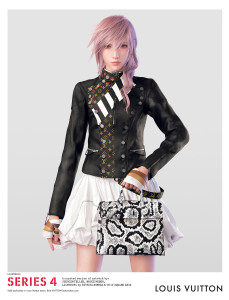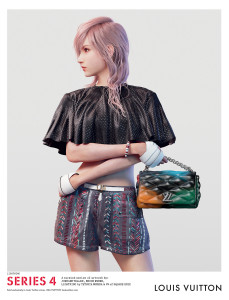If you had been to any big malls recently and were some sort of a fashion conscious person, you must have noticed that “weird” campaign poster outside every Louis Vuitton stores. Right, it is a video game character holding that LV bag. No matter how confusing that seems to you, Nicolas Ghesquière, the creative director of LV was proud of their new face. “Lightning is the perfect avatar for a global, heroic woman and for a world where social networks and communications are now seamlessly woven into our life,” he said.
https://www.youtube.com/watch?v=ImWljqM8kG8
The heroic, pink-haired figure you saw was Lighting. The female character is one of cult Japanese video game Final Fantasy XIII’s main protagonists and she has millions of devoted gaming fans worldwide.
The fashion industry is known for pushing boundaries, but this might just be its most unlikely muse yet – a computer-generated character. Well, non-video game players like us may never get it. But apparently, Louis Vuitton is using this character to target young generations in its Asia market. What surprised me most was that those Final Fantasy fans did buy the idea and were actively shouting out their love for LV on social media.
This campaign does bring up the topic of fictional character endorsement. Fictional character endorsement has been a popular branding tactic and marketing trend over the last decades. Rather than choosing product placement to leap into the fictional worlds of movies and TV, some brands are extrapolating fictional characters into the real world, where are they are used to promote products to the public. Some benefits of such strategy has been identified:
The most notable benefit of using well-known fictional characters, as I mentioned before, is that brands will have the ability to reach a wider audience including the character’s fan base.
Besides of that, consumers nowadays desire more for some “real” connections with brands, and characters are a solution to offering a “human touch”. It is said that, “the interesting thing about characters is that they can get closer to real life than simply using real life people”. And sometimes people see themselves or their ideal self in certain characters and perceive that as what they are looking for.
Character creation can also be a good option for brands looking to revitalize their image and positioning. But it must be carefully thought out on the alliance fit between the character and the brand. For example, for luxury brand that are about personality and connection, character marketing could play a significant role. While for brand such as technology or some other that are less of a human touch, characters may not help much.
Allow me ask at the very end, what do you think of the LV campaign?
References
Louis Vuitton unveils candy-haired character from cult Japanese video game Final Fantasy as the unlikely new face of its SS16 campaign. Retrieved from http://www.dailymail.co.uk/femail/article-3385036/Louis-Vuitton-unveils-candy-haired-character-cult-Japanese-video-game-Final-Fantasy-unlikely-new-face-SS16-campaign.html
‘I am proud to be chosen’: Final Fantasy character Lightning on being welcomed into the Louis Vuitton ‘family’. Retrieved from http://www.telegraph.co.uk/fashion/people/final-fantasy-character-lightning-on-starring-in-louis-vuitton-c/
James Bond: Secret Agent, Ladies’ Man, and Brand Ambassador: Endorsement and Promotion from Fictional Characters. Retrieved from https://www.qualitylogoproducts.com/blog/james-bond-brand-ambassador-endorsement-fictional-characters/
S&E Insights: Best Practices for Brands – Fictional Character Endorsers. Retrieved from http://www.sesponsorshipgroup.com/main-news/2014/01/se-insights-best-practices-for-brands-fictional-character-endorsers
http://www.chinaluxus.com/20151231/058401.html



2 Responses to Fictional Character Endorsement